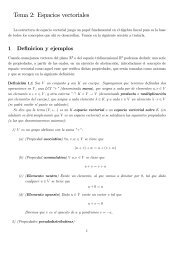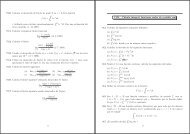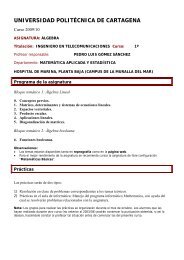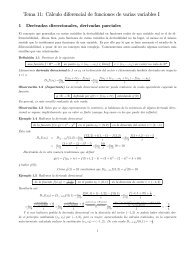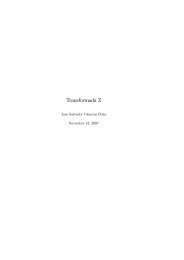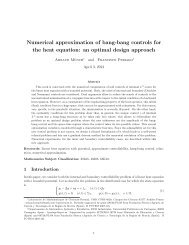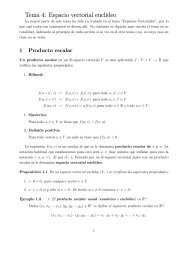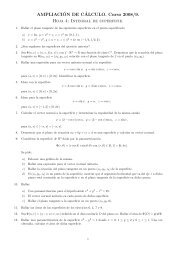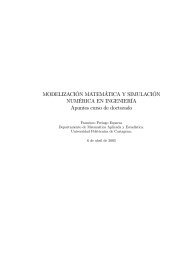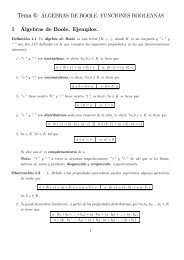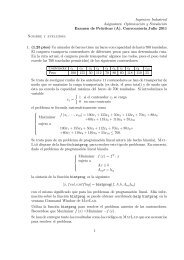Métodos numericos: ecuaciones diferenciales ordinarias
Métodos numericos: ecuaciones diferenciales ordinarias
Métodos numericos: ecuaciones diferenciales ordinarias
You also want an ePaper? Increase the reach of your titles
YUMPU automatically turns print PDFs into web optimized ePapers that Google loves.
El método de Adams—Bashforth se construye a partir del desarrollo<br />
Z 1<br />
yi+1 = yi + h<br />
0<br />
q(xi + sh)ds<br />
ÃZ 1 pX<br />
µ <br />
s + j − 1<br />
= yi + h<br />
∇<br />
0<br />
j<br />
j=0<br />
j !<br />
f(ti, yi)ds<br />
Ã<br />
pX<br />
= yi + h ∇ j Z 1 µ !<br />
s + j − 1<br />
f(ti, yi)<br />
ds<br />
j<br />
= yi + h<br />
j=0<br />
pX<br />
γj∇ j f(ti, yi),<br />
donde los coeficientes<br />
γ0 = 1,<br />
Z 1 µ <br />
s + j − 1<br />
γj =<br />
ds, j =1, 2, ..., p,<br />
0 j<br />
se calculan de forma directa. De hecho, los primeros coeficientes son<br />
j=0<br />
γ 1 γ 2 γ 3 γ 4 γ 5 γ 6<br />
1<br />
2<br />
5<br />
12<br />
3<br />
8<br />
251<br />
720<br />
0<br />
95<br />
288<br />
Además, el error local de truncamiento es de la forma<br />
19087<br />
60480<br />
ti+1 = −h p+2 γ p+1y p+2 (ti; t0, y0)+O(h p+3 ),<br />
<strong>Métodos</strong> multipaso<br />
por lo que es orden O(hp+2 ). Así, si buscamos un método de error global O(h3 ), necesitaremos que<br />
p =2,siendoelmétododelaforma<br />
µ<br />
yi+1 = yi + h f(ti, yi)+ 1<br />
2 ∇f(ti, yi)+ 5<br />
12 ∇2 <br />
f(ti, yi)<br />
µ<br />
= yi + h f(ti, yi)+ 1<br />
2 [f(ti, yi)+f(ti−1, yi−1)]<br />
+ 5<br />
12 [f(ti,<br />
<br />
yi) − 2f(ti−1, yi−1)+f(ti−2, yi−2)]<br />
= yi + 1<br />
12 h (23f(ti, yi) − 16f(ti−1, yi−1)+5f(ti−2, yi−2)) .<br />
Como vemos, al método de Adams—Bashforth le podemos aplicar el teorema de convergencia global,<br />
por lo que será convergente, al contrario de lo que ocurría con el primer ejemplo que estudiamos.<br />
3.4.2 <strong>Métodos</strong> de Adams—Moulton<br />
Los métodos de Adams—Moulton se obtienen de igual manera que los explícitos de Adams—Basfhforth,<br />
pero ahora tomando el polinomio interpolador en t = ti+1 + sh, conloque<br />
q ∗ µ <br />
s +1<br />
(t) = f(ti+1, yi+1)+s∇f(ti+1, yi+1)+ ∇<br />
2<br />
2 µ<br />
s + p − 1<br />
f(ti, yi)+... +<br />
p<br />
53<br />
<br />
∇ p f(ti+1, yi+1)



